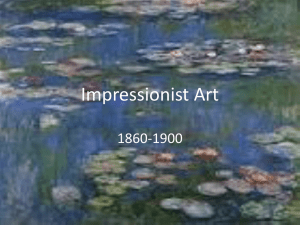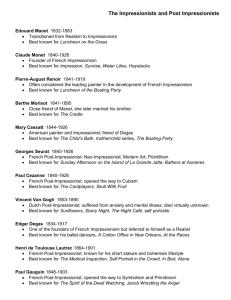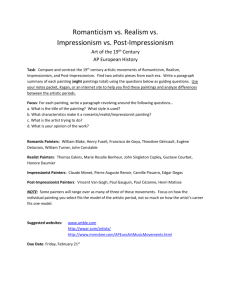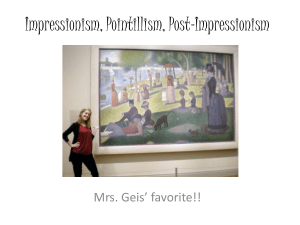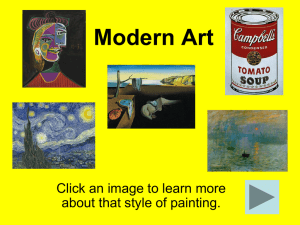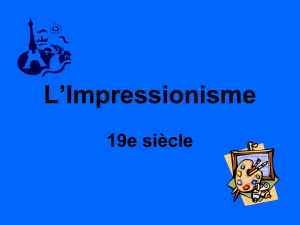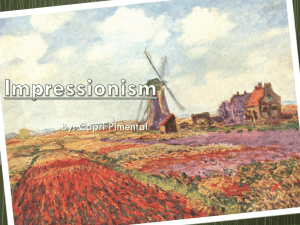Impressionism and Post-Impressionism: What*s the Difference?
advertisement
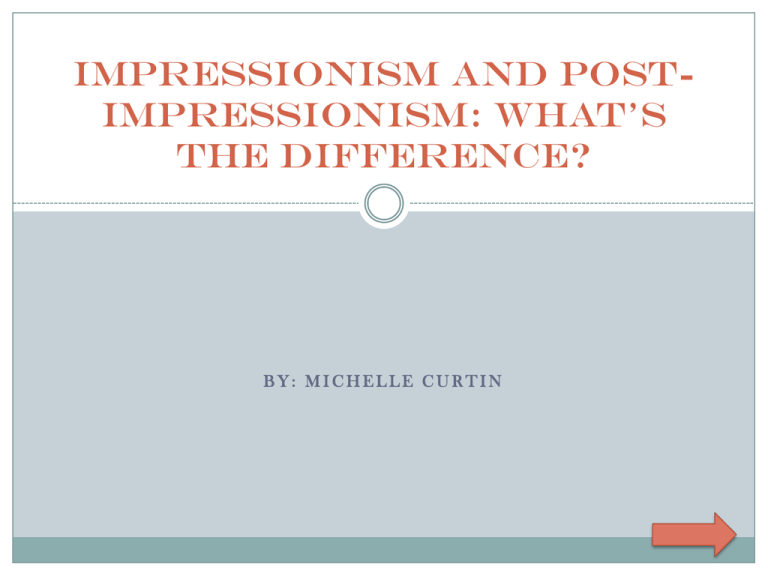
Impressionism and PostImpressionism: What’s the Difference? BY: MICHELLE CURTIN Audience This lesson is intended for a high school introductory painting class. The general location would be a high school in the middle class suburbs that has computer access. Environment This lesson is intended to be completed after class as an individual at home assignment Students may work in a school computer lab during study hall or after school to complete the assignment Objective 1: Impressionism Students will be able to identify the main characteristics of Impressionist art by reviewing slides with compare and contrast information and then completing a quiz where they identify a paintings as either Impressionist or PostImpressionist with 100% accuracy. Objective 2: PostImpressionism Students will be able to identify the main characteristics of Post-Impressionist art by reviewing slides with compare and contrast information and then completing a quiz where they identify a paintings as either Impressionist or PostImpressionist with 100% accuracy. Impressionism and PostImpressionism: So What’s the Difference? Table of Contents This is the home page! Click the house button on the bottom of the slides to return here and jump to a section: Impressionism Post-Impressionism Compare/Contrast Quiz Impressionism QUI Z Impressionism: an Introduction Impressionism was a nineteenth century art movement of Parisian artists. The name comes from Claude Monet’s piece “Impression Sunrise”. QUI Z Impressionist Characteristics Small, thin, visible brush strokes Open composition Accurate depiction of light Ordinary subject matter Movement Painting “en plein air” or “in the open air” QUI Z The Main Impressionists Frederic Bazille Gustave Caillebotte Mary Cassatt Paul Cezanne Edgar Degas Armand Guillaumin Edouard Manet Claude Monet Berthe Morisot Camille Pissarro Pierre-Auguste Renoir Alfred Sisley QUI Z Edouard Manet’s “Café Concert” Note the ordinary subject matter and the visible brushstrokes that create realistic light effects. QUI Z Pierre-Auguste Renoir’s “The Two Sisters on the Terrace” Note the visible brushstrokes, open composition, and en plein air approach. QUI Z Claude Monet’s “Impression” Note the small, thin brushstrokes, the open composition, and the movement in the piece. QUI Z Post-Impressionism QUI Z Post-Impressionism: an Introduction Post Impressionism describes the progression of French art since Manet. Post-Impressionists extended Impressionism while rejecting it’s limitations. QUI Z Post-Impressionist Characteristics Vivid colors Thick paint application Visible brush strokes Real-life subjects Geometric forms Distortion Unnatural or arbitrary color QUI Z The Main PostImpressionists Henri Rousseau Paul Gaugin Vincent Van Gogh Georges Seurat Toulouse Lautrec Emile Bernard Odilon Redon QUI Z Vincent Van Gogh’s “Bedroom in Arles” Note the colors, brush strokes, geometric forms, and distortion. QUI Z Henri de Toulouse Lautrec’s “Equestrienne at the Cirque Fernando” Note the brushstrokes, geometric forms, and distortion. QUI Z Paul Gauguin’s “Midday Nap” Note the unnatural colors, thick paint application, real life subject matter, geometric forms, and distortion. QUI Z Compare and Contrast -open composition -accurate light -ordinary subjects -movement -”en plein air” -small visible brush strokes -ordinary subject matter -vivid colors -thick paint application -geometric forms -distortion -unnatural color QUI Z QUIZ If you feel ready, you can take the quiz! If not, go back and review! Question 1 Is this painting… A B Impressionist Post-Impressionist a. Impressionist No, Try again! Hint: Think about the abstract brushstrokes. b. Post-Impressionist Correct! Question 2 This movement involved something called “en plein air”. This movement is… A B Impressionism Post-Impressionism a. Impressionism Correct! Now what does “en plein air” mean? A B C In the open air Painting outdoors Both a & b b. Post-Impressionism Sorry, try again! a. In the open air Almost! Try again! b. Painting outdoors Halfway there! Try again! c. Both a and b Correct! Question 3 This painting is an example of… A Open Composition B Linear Perspective C Surrealism a. Open Composition Correct! b. Linear Perspective Sorry, this painting demonstrates more of an atmospheric perspective than a linear perspective. c. Surrealism Sorry, this is an Impressionist painting, not Surrealist. Question 4 The attribute that is not in both Impressionism and PostImpressionism is… A Visible brushstrokes B Real-life subject matter C Geometric forms a. Visible Brush Strokes No, try again. b. Real-life Subject Matter No, sorry. c. Geometric Forms Correct! This is only found in Post-Impressionism. Question 5 This painting is… A Impressionist B Post-Impressionist a. Impressionist Correct! b. Post-Impressionist Sorry, try again. You have Completed the Quiz! Congratulations! You have now mastered the basics of Impressionist and Post-Impressionist painting.
